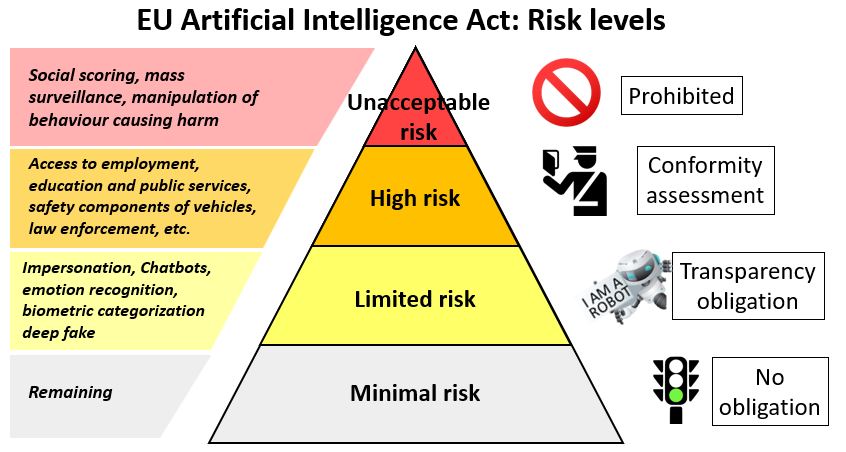AI Regulation In Europe: The Impact Of Trump Administration Pressure

Table of Contents
The Clash of Regulatory Approaches
Europe's Focus on Data Privacy and Ethical AI
The EU's approach to AI regulation is fundamentally shaped by its commitment to data privacy, most notably enshrined in the General Data Protection Regulation (GDPR). This regulation, with its emphasis on individual consent and data minimization, has profoundly impacted AI development within the EU. Furthermore, Europe champions explainable AI (XAI), demanding transparency in algorithms to ensure accountability and prevent discriminatory outcomes. This proactive approach contrasts sharply with the more reactive stance of the US during the Trump administration.
- Strict data protection rules: The GDPR imposes stringent requirements on data collection, processing, and storage, impacting how AI systems utilize personal information.
- Emphasis on human oversight: European regulators prioritize human control over AI systems, aiming to mitigate risks and ensure ethical considerations are paramount.
- Focus on preventing bias and discrimination: Regulations are being developed to address algorithmic bias and ensure fairness in AI applications, minimizing discriminatory outcomes.
The Trump Administration's Deregulatory Stance
In contrast to the EU's proactive approach, the Trump administration favored a lighter-touch regulatory environment for AI. This stance prioritized innovation and economic competitiveness over stringent data protection and ethical considerations. This difference in philosophy created significant tension between the two regions, hindering potential collaboration and creating regulatory divergence.
- Opposition to stringent data protection rules: The Trump administration expressed concerns that robust data protection regulations, like the GDPR, would stifle innovation and hinder economic growth.
- Emphasis on innovation over regulation: The prevailing sentiment was that excessive regulation could impede the development and deployment of AI technologies, thereby putting the US at a competitive disadvantage.
- Concerns about hindering technological advancement: The administration argued that a less regulated environment would foster faster innovation and allow the US to maintain its leadership in the global AI race.
Transatlantic Tensions and Trade Implications
Data Transfer Challenges and Regulatory Divergence
Differing regulatory approaches created significant challenges for companies operating on both sides of the Atlantic. The GDPR's strict data protection rules made transatlantic data transfers complex and costly, creating potential trade barriers and hindering international collaboration in AI research and development.
- Difficulties in data sharing: Transferring data between the EU and US became significantly more difficult due to the differing regulatory landscapes, requiring complex legal frameworks and compliance measures.
- Increased compliance costs: Companies faced increased costs in complying with both EU and US regulations, adding a significant burden, especially for smaller businesses.
- Potential for trade disputes: The regulatory divergence created the potential for trade disputes and retaliatory measures, further complicating the already tense transatlantic relationship.
Negotiating a Common Ground (or Lack Thereof)
During the Trump era, attempts at finding common ground on AI regulation were largely unsuccessful. Political disagreements and differing regulatory philosophies hampered the development of shared standards and created a fragmented global AI governance landscape.
- Limited cooperation on AI standards: The lack of a shared regulatory framework resulted in limited cooperation on establishing common AI standards, leading to inconsistencies and difficulties for international collaboration.
- Increased fragmentation of global AI governance: The divergence between EU and US approaches contributed to a more fragmented global landscape, making it harder to establish consistent and effective AI governance worldwide.
- Challenges to international collaborations: The regulatory differences made it difficult to facilitate international collaborations in AI research, development, and deployment.
Long-Term Impacts on European AI Regulation
Strengthening of European Sovereignty in AI
Ironically, the Trump administration's pressure may have inadvertently strengthened the EU's resolve to pursue its own path in AI regulation. This has led to increased investment in ethical AI research, the development of EU-specific AI standards, and the attraction of AI talent seeking a more regulated environment.
- Increased investment in ethical AI research: The EU has significantly increased investment in research and development focused on ethical and trustworthy AI, solidifying its commitment to its regulatory approach.
- Development of EU-specific AI standards: The EU is actively developing its own set of AI standards, further differentiating its approach from other regions and strengthening its regulatory sovereignty.
- Attracting AI talent seeking a more regulated environment: The EU's emphasis on ethical AI and data protection is attracting AI talent who prefer a more responsible and regulated environment.
Potential for Future Cooperation (or Continued Divergence)
The future of transatlantic relations on AI regulation remains uncertain. While opportunities exist for renewed dialogue and collaboration, the risk of continued regulatory fragmentation persists. The outcome will depend heavily on the willingness of both sides to find common ground on core principles.
- Opportunities for renewed dialogue and collaboration: There is potential for increased cooperation under future administrations, focusing on shared principles and common goals.
- Potential for convergence on core principles: Despite existing differences, there is a possibility for future convergence on core principles, such as algorithmic transparency and accountability.
- Risk of continued regulatory fragmentation: However, the lack of cooperation could lead to continued regulatory fragmentation, hindering international collaboration and potentially harming global innovation.
Conclusion
The Trump administration's pressure significantly impacted AI regulation in Europe, highlighting existing transatlantic differences and creating significant challenges for globally operating businesses. While this pressure may have strengthened the EU's commitment to its approach, the long-term consequences for international AI cooperation remain uncertain. The future hinges on the EU and US finding common ground on data privacy, algorithmic transparency, and ethical AI development. To stay informed on this crucial aspect of global technology policy, continue to research and follow updates on AI regulation in Europe and beyond. The future of AI regulation depends on informed participation and engagement.

Featured Posts
-
 The Importance Of Middle Managers Benefits For Companies And Employees
Apr 26, 2025
The Importance Of Middle Managers Benefits For Companies And Employees
Apr 26, 2025 -
 Nfl Draft 2024 Will Ahmed Hassanein Break New Ground
Apr 26, 2025
Nfl Draft 2024 Will Ahmed Hassanein Break New Ground
Apr 26, 2025 -
 The Next Fed Chair Inheriting Trumps Economic Challenges
Apr 26, 2025
The Next Fed Chair Inheriting Trumps Economic Challenges
Apr 26, 2025 -
 China Made Vehicles The Future Of The Auto Industry
Apr 26, 2025
China Made Vehicles The Future Of The Auto Industry
Apr 26, 2025 -
 Strategic Military Base A Focal Point In The Us China Power Struggle
Apr 26, 2025
Strategic Military Base A Focal Point In The Us China Power Struggle
Apr 26, 2025
